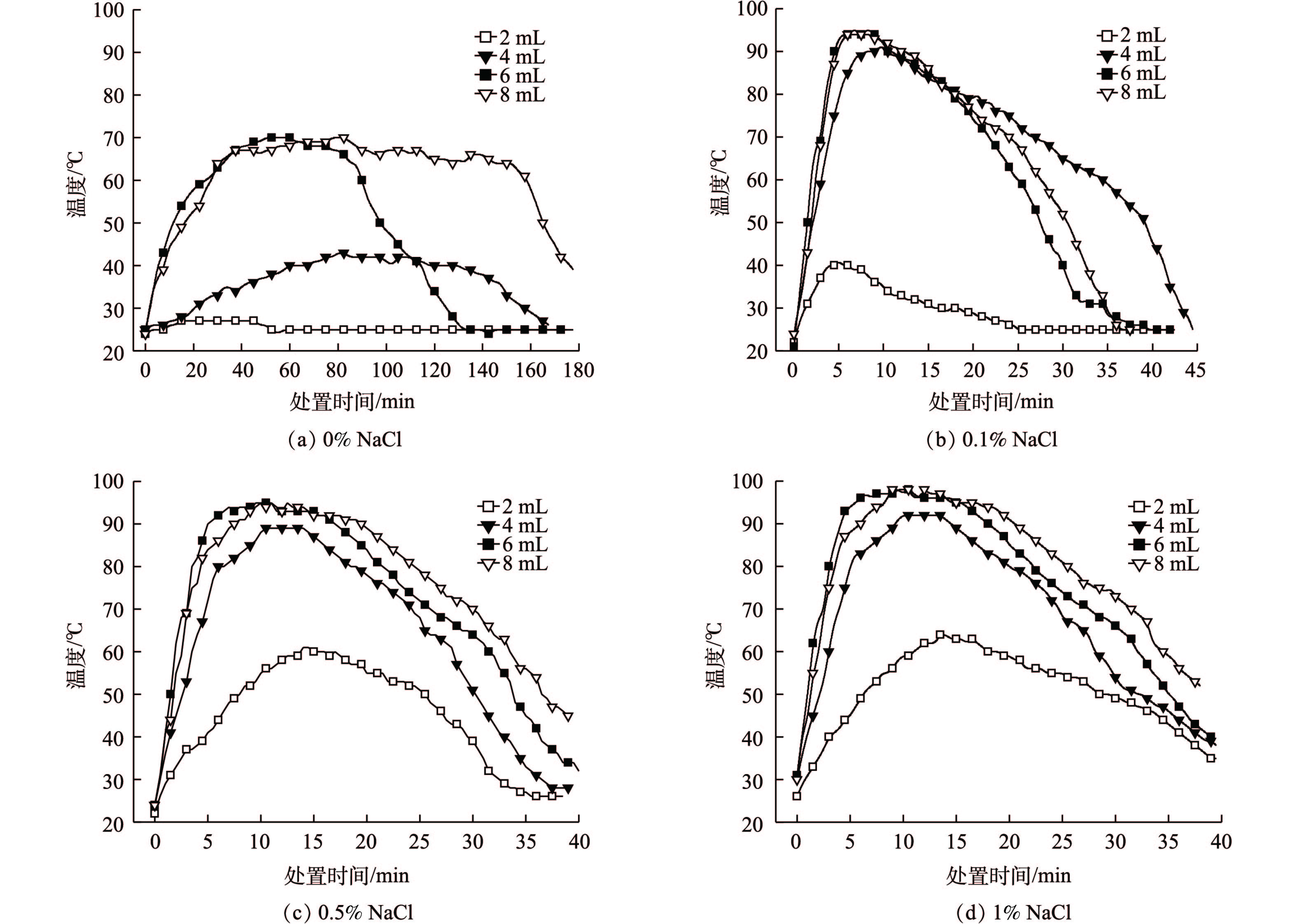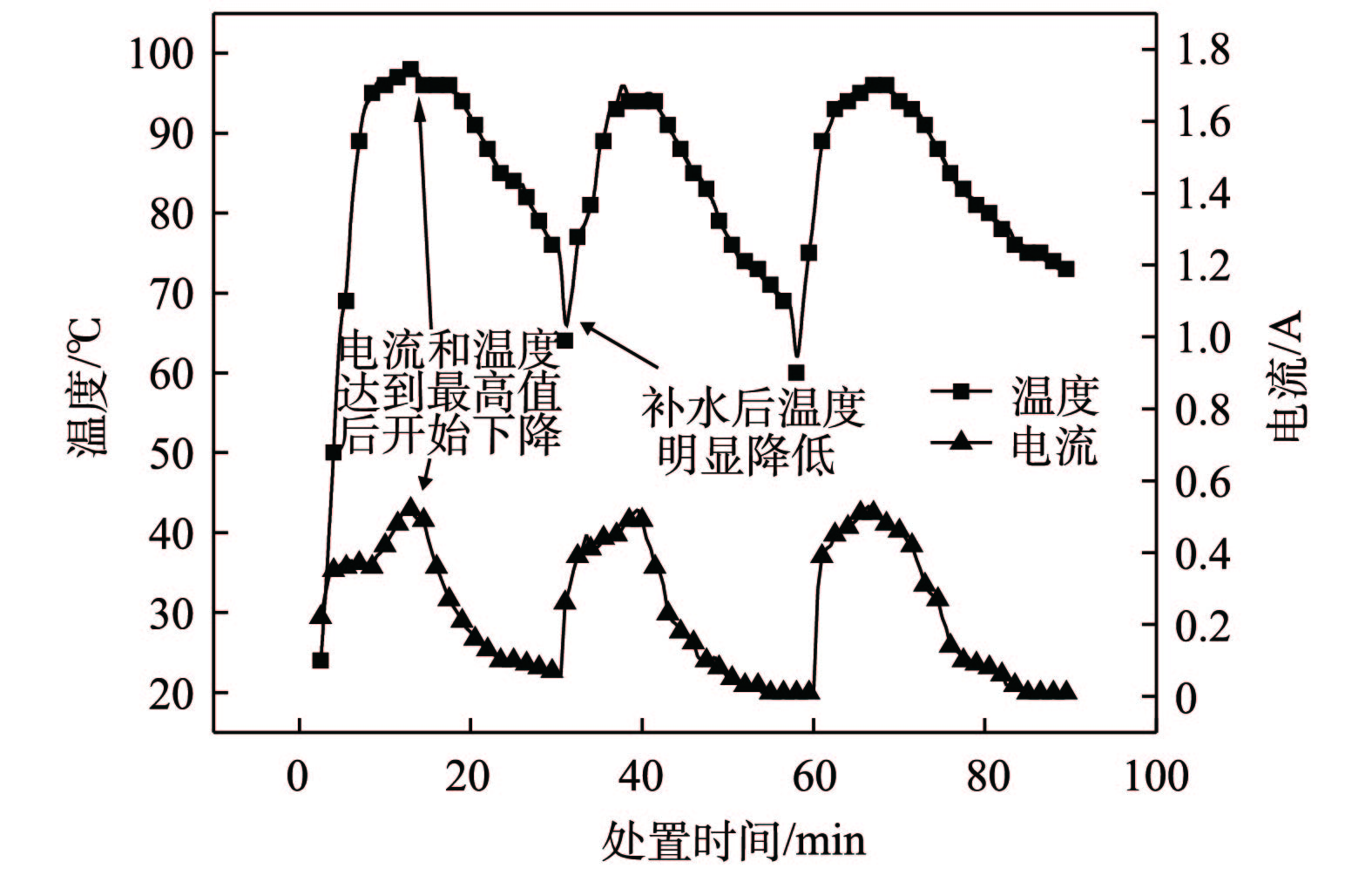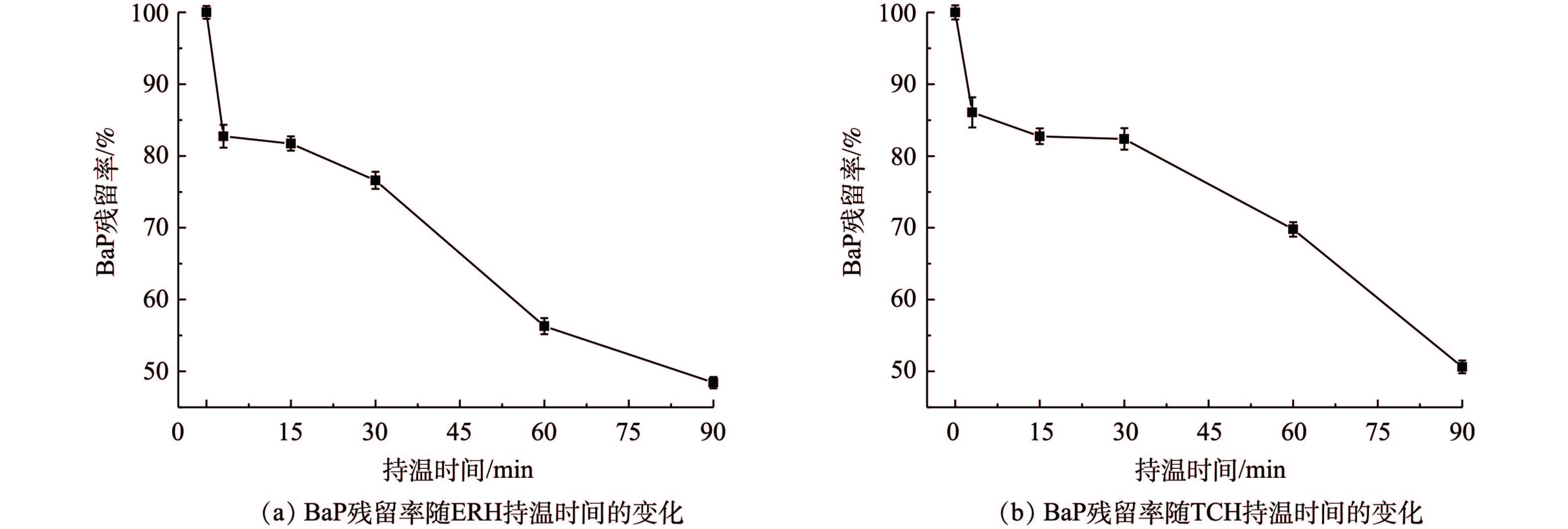Fe2+活化过硫酸氢钾复合盐降解吲哚美辛
Degradation of indomethacin in aqueous by peroxymonosulfate activated by ferrous ion
-
摘要: 通过亚铁离子活化过硫酸氢钾复合盐产生氧化性的硫酸根自由基,以吲哚美辛(IM)为目标污染物,研究了不同亚铁离子浓度和过硫酸氢钾浓度,以及加入Cl-离子和腐殖酸对吲哚美辛降解情况的影响。结果表明,[IM]:[PMS]:[Fe2+]=1:2:2条件下,IM的去除率接近100%;低浓度的Cl-抑制吲哚美辛的降解,高浓度则为促进作用;而腐殖酸都在不同程度上抑制了吲哚美辛的降解。经淬灭实验表明,亚铁离子活化过硫酸氢钾降解吲哚美辛中起主要作用的自由基是SO4-·。该方法能在短时间内高效降解吲哚美辛,为实际废水中吲哚美辛去除提供参考。Abstract: The degradation of indomethacin (IM) by the ferrous-ion-activated sodium peroxymonosulfate (PMS) was investigated.This process is based on the generation of sulfate radicals,which are powerful oxidizing species in aqueous phase.The effects of varying concentrations of Fe2+ and PMS and the addition of Cl- and humic acid (HA) on the degradation efficiencies of IM were studied.The results showed that the removal of IM was close to 100% at the molar ratio of [IM]:[PMS]:[Fe2+]=1:2:2.A low concentration of Cl- had a negative effect and a high concentration of Cl- had a positive effect on the degradation of IM,whereas HA had a negative effect.The results of quenching experiments revealed that SO4-· was the major active radical that contributed to the degradation of IM by ferrous-ion-activated peroxymonosulfate.This method could efficiently degrade IM in a short time,which could help in the treatment of actual wastewater contaminated by IM.
-
Key words:
- indomemthacin /
- ferrous ions /
- peroxymonosulfate /
- SO4-· /
- Cl-
-
近年来,随着我国“退二进三”、“退城进园”和“产业转移”等政策的实施,全国几乎所有大中城市都面临着重污染行业的企业关闭和搬迁问题,导致城市及周边地区出现大量遗留、遗弃有机污染场地[1]。这些污染场地已对人体健康和生态环境造成严重危害,且面临着急切的二次开发利用的难题,制约了城市的建设与发展[2]。多环芳烃(polycyclic aromatic hydrocarbons,PAHs)是石化、焦化行业污染场地土壤中典型有毒、有害有机污染物,具有“三致效应”及生物毒性[3]。人类活动(如化石燃料不完全燃烧、工业生产、垃圾焚烧等)是环境中PAHs的主要来源[4],PAHs水溶性差且易与土壤有机质结合,进入土壤微孔不易释放出来,在土壤中的积累对环境形成威胁[5]。美国环境保护署已经将萘、菲、苯并(a)芘(benzo(a)pyrene,BaP)等16种PAHs列为优先控制污染物[6],其中BaP是PAHs代表性致癌物,可诱发多种癌症,在2006年,国际癌症研究机构(IARC)已将BaP归为Ⅰ类致癌物[7]。
目前,可用于修复PAHs污染土壤的原位修复技术主要包括热脱附、化学氧化、土壤洗涤、生物降解等[8]。原位热脱附技术自20世纪70年代开始应用于有机污染场地的修复,包括蒸汽强化提取技术、电阻加热技术、热传导技术和射频加热技术等[9]。原位热脱附技术的优点在于无须挖掘和运输污染土壤,二次污染相对可控,能够节约修复成本,对低渗透、不均质污染区域具有较强的适用性和较高的修复效率[8]。原位电阻加热修复技术(electrical resistance heating,ERH)基于欧姆定律,将电能转化为热能,提高土壤温度,即电场加速自由电荷载体转移动能引起能量转换[10-11]。ERH将土壤加热后,增加了土壤蒸汽压,并使部分污染物与水溶液发生共沸从而分离[12],最终通过气相抽提将污染物转移并处置。
已有研究证实,ERH对土壤中有机污染物具有很高的去除率。ZUTPHEN等[13]利用二维沙箱实验研究了电阻加热强化土壤气相抽提对土壤中三氯乙烯(TCE)的修复,结果表明,TCE的去除率较气相抽提提升了19倍,最终去除率为99.87%。MARTIN等[14]使用ERH对土壤中TCE进行修复,最终达到去除96.96%的修复目标。国内原位热脱附修复技术的研究和应用起步较晚。岳昌盛等[15]的研究证实,低温热解析通过增加保温时间能促进焦化场地中苯和多环芳烃解吸分离,表明在低温加热条件(<200 ℃)下,通过延长热脱附时间可以促进污染物的解析分离,达到工业/商服工地筛选值(0.4 mg·kg−1),类似的研究还有针对土壤中的五氯酚[16]、有机氯溶剂[17]等的解析分离。
ERH的主要影响因素包括土壤质地[18]、电导率、水分[10]以及电场强度[14]等。与砂土相比,黏土能优先加热,整体加热速率更高[17];高土壤导电性有助于电流的输送,从而产生较高的加热速率[17];土壤水分可以提供离子传输通道,促进加热[19],但地下水通量可能限制加热[20]。然而,基于实验室规模的ERH装置对这些因素的研究较少,难以筛选出最优条件。
鉴于BaP筛选值较低、难降解、毒性当量参数(TEFs)[21]大的特点,本研究以BaP为目标污染物,利用自制电阻加热小试装置,研究了土壤水分、盐分含量和电场强度对土壤电阻加热的影响,并结合热传导加热装置,在低温条件下,比较了2种加热方式对BaP的去除效果,为电阻加热技术修复BaP污染土壤提供参考。
1. 材料与方法
1.1 实验材料
实验土壤取自张掖市某未污染场地,其BaP含量为43 μg·kg−1。破碎干燥后,在混料机中混匀,然后进行研磨,在烘干机中烘干。取多环芳烃溶液100 mL,与100 g土壤充分搅拌混合,自然干燥后,在混料机中混匀,过200目筛后,密封避光,冷藏保存。供试土壤的基本理化性质见表1,BaP理化性质及供试土壤污染情况见表2。建设用地筛选值(SL)为《土壤环境质量建设用地土壤污染风险管控标准(试行)》(GB 36600-2018)[22]中的第一类用地筛选值。
表 1 供试土壤基本性质Table 1. Basic characteristics of tested soils粒径分布/% pH 1~0.05 mm 0.05~0.005 mm < 0.005 mm 93.49 4.66 1.85 7.7 有机质含量/% N含量/% P含量/% K含量/% 0.97 0.84 0.32 0.33 表 2 苯并(a)芘的理化性质及供试土壤的污染情况Table 2. Physicochemical properties of BaP and contamination analysis of tested soils环数 相对分子质量 熔点/℃ 沸点/℃ lgK 5 252.0 179 475 5.91 毒性当量参数(TEFs) 理论浓度/(mg·kg−1) 实测浓度/(mg·kg−1) 建设用地筛选值(SL)/(mg·kg−1) 1 1.5 1.39 0.55 多环芳烃标准溶液、多环芳烃萃取溶剂二氯甲烷、正己烷以及5种回收率指示物(Nap-d8、Ace-d10、Phe-d10、Chr-d12和Pyr-d12)均为分析纯试剂,购自上海安谱实验科技股份有限公司。以BaP试剂对供试土壤进行模拟污染,取150 mg·L−1的BaP标准溶液1 mL,用5%乙腈溶液于100 mL容量瓶中定容,将市售标准溶液稀释为浓度1.5 mg·L−1的缓冲溶液。
1.2 实验方法
电阻加热装置如图1所示。加热系统为自制坩埚装置,由带盖坩埚、绝缘层、排气孔、电极组成,固定于支架上,接通交流电进行加热。坩埚中每次实验放入15 g实验土壤。热传导加热装置如图2所示。主要由载气系统、加热系统、尾气处理系统组成。载气系统采用标准氩气,加热系统采用管式炉加热装置,尾气处理系统由装有纯正己烷溶液的吸收瓶和活性炭吸附器串联组成。管式炉中的石英管长1 m,内径80 mm。将15 g实验土壤置于瓷船中,推入加热区,在选定的ERH温度条件下,对石英管进行同阶段加热。
根据MARTIN等[14]的研究以及前期实验,确定在6 V·cm−1和8 V·cm−1的电场强度下,分别设置4组土壤水分、盐分实验(纯水、0.1%、0.5%和1% NaCl溶液,每组添加量分别为2、4、6、8 mL),研究电解质溶液对土壤电阻加热的影响。
设置6个持温时间梯度(0、3、15、30、60、90 min),TCH温度设置多段式加热方式,升温、降温区间与ERH处理基本同步,研究并比较不同持温时间对去除率的影响,每组实验设置3个平行样。加热结束后,取3份平行土壤样品,每份3 g,分别装入聚四氟离心管中,加入1.8 g无水硫酸钠、3片铜片,然后加入200 μL回收率指示物。3次二氯甲烷和正己烷超声提取,离心后合并提取液,旋蒸并氮吹定容至1 mL,使用气相色谱质谱联用仪测定其中的多环芳烃含量。
1.3 仪器分析与数据分析
气相色谱质谱联用仪为安捷伦三重串联四级杆气相质谱仪(Agilent 7000B,安捷伦,美国),配备DB-5MS色谱柱(30 m×0.25 mm×0.25 μm)。进样口和检测器的温度分别为275 ℃和280 ℃,不分流进样,样品体积1 μL。升温程序为:以18 ℃·min−1速度升至140 ℃,再以12 ℃·min−1速度升至240 ℃,保持1 min,后以5 ℃·min−1速度升至280 ℃,保持10 min。气相色谱检测信号采用安捷伦EZ Chrome软件收集和处理。采用SPSS 22软件,对不同时间处理后土壤中BaP残留浓度进行热脱附动力学拟合,比较处理之间的差异显著性。
2. 结果与讨论
2.1 电解质溶液对土壤电阻加热的影响
在电场强度为6 V·cm−1条件下,NaCl溶液浓度及添加量对土壤电阻加热的影响见图3。结果表明,水分是土壤电阻加热的基本条件,有足够的水分(>2 mL)提供离子传输通道,土壤才能被有效加热,水分较高的土壤升温速率高于干燥土壤[19]。与纯水相比,不同浓度NaCl溶液(图3(b)~(d))对土壤电阻加热升温明显,最高温度均远高于纯水条件下的温度,表明土壤盐分也是土壤电阻加热的重要因素。因为土壤电导率(σ)是ERH的重要影响因素之一,是目标加热区域内孔隙水饱和度、矿物成分、温度和溶解离子在时间和空间上变化的函数[10],而离子浓度是土壤电导率的基本参数,土壤盐分是离子的主要来源[23]。加入NaCl溶液可以增加土壤离子浓度,从而增加土壤电导率和土壤电阻加热功率,致使土壤加热效率增加[10],这与电流温度变化结果一致。水或NaCl溶液添加量增加时,土壤加热速率和所测温度均升高,温度保持时间增加。当添加量为8 mL时,土壤加热速率最大,所测温度最高,分别达到43、51、79和97 ℃,对应的持温时间最长,这表明土壤水分影响持温时间。在ERH实际应用中,水分是维持ERH动态平衡的重要条件[19]。当NaCl溶液浓度增大时,土壤加热速率和最高加热温度明显升高,表明增加土壤盐分含量对ERH有促进作用。添加1% NaCl溶液,升温速率最快,可以达到最高温度。当0.5%和1% NaCl溶液添加量分别达到4 mL之后,加热效率差别不明显,其最高温度接近(分别为80 ℃和94 ℃),这可能是由于水和离子浓度达到饱和状态,之后出现降温是由于孔隙水蒸发,离子传输通道不足以进行加热。
2.2 电场强度对土壤电阻加热的影响
在电场强度为8 V·cm−1条件下,NaCl溶液浓度及添加量对土壤电阻加热的影响见图4。图4再次证实水分是土壤电阻加热的基本条件。随水分和盐分含量的增加,土壤加热效率和最高温度逐渐增加,当水或NaCl溶液添加量为8 mL时,土壤加热速率最大,加热温度最高,分别达到70、95、95和97 ℃。这些结果与图3一致。当添加0.1%、0.5%和1% NaCl溶液达到4 mL之后,加热效率差别不明显。
在8 V·cm−1的电场强度条件下,添加纯水可以达到70 ℃,高于6 V·cm−1电场强度下的43 ℃;添加0.1% NaCl溶液可以达到95 ℃,远高于6 V·cm−1电场强度下的51 ℃,表明电场强度是土壤电阻加热的重要因素。由于添加0.1% NaCl溶液2 mL后加热效果较差,因此,由实验确定的ERH最优条件为:在8 V·cm−1的电场强度下,0.1%的NaCl溶液最小添加量为4 mL,最优添加量为6 mL。该电场强度略低于MARTIN等[18]的最高电场强度(8.57 V·cm−1),且符合GB 50054-2011[24]。添加6 mL的0.1% NaCl溶液可以达到ERH的要求,且其盐分含量(4×10−4)远低于盐碱化土壤0.1%的标准[25],不会造成土壤盐渍化等问题。
2.3 电流对土壤电阻加热的影响
如图5所示,根据ERH条件筛选实验,选取电场强度8 V·cm−1、添加6 mL的0.1% NaCl溶液为本研究污染土壤处置ERH条件。随电流的升高,温度也开始升高,13 min时,电流达到最高值0.52 A,温度达到最高值97 ℃。随后电流急剧下降,温度开始缓慢降低,这可能是因为大部分水分沸腾蒸发,离子传输通道不足以进行加热,而温度由于土壤比热容的存在缓慢下降[10]。之后在30 min和60 min时,加入6 mL纯水保持土壤水分含量。因为加入常温纯水,温度明显降低,补充水分后电流与土壤加热功率回升,随后2~5 min土壤加热温度升高,分别再次出现电流和温度的峰值。整个ERH过程的温度变化与电流变化基本同步,这与HEGELE等[10]的ERH模拟温度和气体饱和度随电流的变化结果一致。由于电导率随温度和气体饱和度的变化而变化,在场地规模的ERH应用中,只有将电流测量与温度测量相结合,才能从温度效应中分离出气体饱和度效应,从而推断出气体产量。离电极较近的土壤更容易干燥,使土壤电阻增大,热修复效率降低,因此,在土壤电阻加热过程中,须补水保持ERH动态平衡[10, 26]。实验得到的补水点等相关工艺参数,可以为场地实际工程提供数据支撑。
2.4 ERH与TCH对土壤BaP的去除效果比较
为验证ERH去除污染土壤BaP的可行性,在电场强度为8 V·cm−1条件下,添加6 mL的0.1% NaCl溶液,TCH温度设置多段式加热方式,升温、降温区间与ERH处理基本同步。分别对污染土壤进行ERH和TCH处置,研究了不同加热方式对土壤BaP去除效果的影响。土壤BaP残留率与持温时间关系见图6。土壤BaP残留率为加热处理后污染物检出浓度与原始土壤实测浓度的比值。ERH处置的BaP去除率在持温时间为3 min时明显增加,脱附过程先快速后慢速。当持温时间在30 min和60 min后,去除率也明显增加。在补水点(补水点为30、60、90 min)后,土壤BaP残留率明显下降,再次验证了土壤水分是ERH去除污染物的基本条件。
ERH和TCH处置60 min和90 min后的土壤BaP残留率相近。经过90 min的ERH处置后,土壤BaP残留率为48.44%,低于TCH处置后的50.62%。结果表明,持温时间是土壤中BaP去除率的重要影响因素,随持温时间的增加,土壤BaP残留率降低,去除率增加,即在低温条件下,通过延长加热时间可以达到较好的修复效果。这与孙磊等[27]研究低温对五氯酚(pentachlorophenol,PCP)的热修复结果一致,PCP熔点190 ℃,沸点为310 ℃,在125 ℃持温一段时间后,使一定量的PCP从土壤中逸出。在ERH过程中,有机物的亨利常数、蒸汽压和扩散系数都会随着温度的升高而升高,从而增加污染物在气相的分布,促进污染物的挥发[27]。ERH处置90 min后,土壤中BaP残留量略高于GB 36600-2018第一类用地筛选值[22](0.55 mg·kg−1),而陈星等[28]在400 ℃条件下,热修复8 h后,重污染土壤中BaP浓度仍然超过这一筛选值,这表明达标去除土壤中残留的BaP,须继续优化持温时间等关键参数。
近年有研究[21]表明,可以通过提高真空度以及添加碳酸盐类物质来促进PAHs残留量的进一步降低。此外,化学氧化修复技术能高效快速地降解有机污染物,具有广阔的应用前景[29],且应用过硫酸盐进行修复的案列越来越多,其中通过热活化产生具有强氧化能力的硫酸根自由基(
SO−⋅4 )能无选择性地与有机物进行反应[30]。李永涛等[31]采用热活化过硫酸盐法修复柴油污染土壤的温度条件为70 ℃,ERH可满足该条件,因此,可以在处置过程中通过添加过硫酸盐,促进BaP解析分离。已有研究[32]表明,热脱附处理后,土壤有机质成分的变化以及低氮条件尤其适合真菌的生长繁殖,土壤中的PAHs存在进一步生物降解的可能。采用高温热修复,会使土壤中水分甚至有机成分和无机成分破坏[33],且须投入大量能源,对土体持续加热,成本相对较高,同时造成能耗增加[28]。本研究中采用同一种土壤,而不同类型土壤剖面层中PAHs的纵向分布规律不同[34]。在实际污染场地土壤中,PAHs进入土壤后与有机质结合,发生老化反应,即随着时间的延长,PAHs进入有机质内部孔隙而不易释放出来,可提取性降低[35]。本研究中土壤BaP老化时间仅为7 d。PAHs在有机质含量较高的土壤中老化更明显,因为PAHs的吸附主要依赖于土壤有机质[36]。此外,蔡婷等[37]的研究表明,总有机碳(total organic carbon,TOC)与PAHs总量之间呈正相关关系,TOC越高,PAHs残留量越高,纵向迁移量相对减少。TOC对中、高环PAHs(如BaP)迁移的影响高于低环PAHs。因此,须进一步加强关于ERH对不同类型和不同老化时间土壤中的有机质与TOC含量及其如何影响污染物去除率的研究。
2.5 土壤中BaP的热脱附动力学分析
原位热脱附过程一般分为低温和高温脱附2个阶段。在低温加热条件下,土壤中多环芳烃的热分解的可能性很小,热脱附是其去除的主要机制,因此,可以用热脱附动力学描述其脱附过程。常见的热脱附动力学方程包括5种。
一级动力学方程见式(1),Elovich方程见式(2),抛物线扩散方程见式(3),Freundlich动力学方程见式(4),二级动力学方程见式(5)。
lnC=lnC0−k1t (1) C=A+Blnt (2) C=C0Dt0.5+k2 (3) lnC=A+Blnt (4) 1/C=2k3t+1/C0 (5) 式中:C为t时刻土壤污染物浓度,mg·kg−1;C0为土壤污染物初始浓度,mg·kg−1;t为时间,min;k1为一级动力学常数,h−1;D为总扩散系数,m2·s−1;k2为抛物线型扩散动力学方程常数,mg·(g·h1/2)−1;k3为二级动力学常数,g·(mg·h) −1;A和B均为动力学方程常数。
一级动力学方程描述了扩散机制控制的动力学过程,涉及的主要机制单一且能量变化不大;抛物线扩散方程模型描述的是由多个扩散机制控制的过程,最适合描述物质在颗粒内部扩散过程的动力学过程[38];Elovich方程和Freundlich动力学方程皆为经验式,对于单一反应机制的过程不适合,描述的是一系列反应机制的过程,Elovich方程常用于描述反应过程中活化能变化较大的过程,Freundlich动力学方程主要用于描述吸附能随表面饱和度的增加呈指数衰减的过程[39]。对于抛物线扩散模型,无论是颗粒内扩散还是表面扩散都可能是速率受限的。当颗粒阻力决定吸附速度时,表面扩散通常是速率控制机制[40]。
本研究中土壤BaP的热脱附分别采用上述方程拟合,拟合结果见表3。BaP的热脱附过程同时符合一级动力学方程以及抛物线扩散方程,且这2种动力学方程相关系数均能达到显著水平(P=0.01)。由抛物线扩散方程计算结果可知,TCH和ERH条件下土壤中BaP的C0分别为1.64 mg·kg−1和1.21 mg·kg−1,而实测的C0则为1.39 mg·kg−1,表明抛物线扩散方程拟合效果更佳,且ERH理论值更接近实测值。这说明在ERH过程中,土壤BaP的热脱附过程更符合抛物线扩散方程,BaP在污染土壤中的去除以微孔扩散为主,其去除率受加热时间影响大,即随ERH的进行,土壤中BaP会进行有效脱附。在对污染土壤进行热修复时,并不是在土壤温度达到污染物沸点时直接促进其挥发,当土壤温度远低于污染物沸点时,污染物就已被大量提取。
表 3 土壤中BaP脱附动力学拟合方程和R2Table 3. BaP desorption kinetics equation from soils and R2动力学方程 热传导加热BaP 电阻加热BaP 拟合方程 R2 拟合方程 R2 一级动力学方程 lnC=0.989−0.006t 0.989** lnC=1.003−0.004t 0.957** Elovich方程 C=1 688.732−143.677lnt 0.583* C=1 233.1−75.633lnt 0.677* 抛物线扩散方程 C=71.864t0.5+1 641.62 0.823** C =37.413t0.5+1 205.938 0.869** Freundlich动力学方程 lnC=7.497−0.125lnt 0.627* lnC=7.144−0.079lnt 0.653* 注:*表示P < 0.05,**表示P < 0.01。 3. 结论
1)土壤水分、盐分、电场强度是决定土壤ERH升温速率与最高加热温度的关键因素。在电场强度为8 V·cm−1的条件下,添加6 mL的0.1% NaCl溶液是实验室规模ERH的最优条件。
2)土壤水分是维持ERH动态平衡的重要条件。在ERH过程中,须加入纯水保持土壤水分含量,实验中每30 min须补充水分6 mL,其温度和电流变化基本同步。
3)土壤水分与持温时间是去除土壤中BaP的关键因素。污染物去除率在补水点后明显增加,并随持温时间的增加而增加,且须延长持温时间以达到修复目标值。
4)电阻加热对污染土壤中BaP的去除过程符合抛物线扩散模型,表明BaP在土壤中的去除是以微孔扩散过程为主的,去除率受加热时间影响较大,ERH对土壤中BaP可进行有效脱附。在对污染土壤进行热修复时,可以无须将土壤温度加热到污染物沸点,但须根据污染土壤的修复目标优化补水量和持温时间等关键参数。
-
[1] TERNES T.A.,MEISENHEIMER M.,MCDOWELL D.,et al.Removal of pharmaceuticals during drinking water treatment.Environmental Science & Technology,2002,36(17):3855-3863 [2] EDWARDS M.,TOPP E.,METCALFE C.D.,et al.Pharmaceutical and personal care products in tile drainage following surface spreading and injection of dewatered municipal biosolids to an agricultural field.Science of the Total Environment,2009,407(14):4220-4230 [3] YU J.T.,BOUWER E.J.,COELHAN M.Occurrence and biodegradability studies of selected pharmaceuticals and personal care products in sewage effluent.Agricultural Water Management,2006,86(1/2):72-80 [4] LIN A.Y.C.,YU T.H.,LIN Chengfang.Pharmaceutical contamination in residential,industrial,and agricultural waste streams:Risk to aqueous environments in Taiwan.Chemosphere,2008,74(1):131-141 [5] RATOLA N.,CINCINELLI A.,ALVES A.,et al.Occurrence of organic microcontaminants in the wastewater treatment process.A mini review.Journal of Hazardous Materials,2012,239-240:1-18 [6] LIANG Chenju,BRUELL C.J.,MARLEY M.C.,et al.Persulfate oxidation for in situ remediation of TCE.I.Activated by ferrous ion with and without a persulfate-thiosulfate redox couple.Chemosphere,2004,55(9):1213-1223 [7] LIANG Chenju,BRUELL C.J.,MARLEY M.C.,et al.Persulfate oxidation for in situ remediation of TCE.II.Activated by chelated ferrous ion.Chemosphere,2004,55(9):1225-1233 [8] HORI H.,YAMAMOTO A.,HAYAKAWA E.,et al.Efficient decomposition of environmentally persistent perfluorocarboxylic acids by use of persulfate as a photochemical oxidant.Environmental Science & Technology,2005,39(7):2383-2388 [9] ANIPSITAKIS G.P.,DIONYSIOU D.D.Degradation of organic contaminants in water with sulfate radicals generated by the conjunction of peroxymonosulfate with cobalt.Environmental Science & Technology,2003,37(20):4790-4797 [10] ANIPSITAKIS G.P.,DIONYSIOU D.D.Radical generation by the interaction of transition metals with common oxidants.Environmental Science & Technology,2004,38(13):3705-3712 [11] NETA P.,MADHAVAN V.,ZEMEL H.,et al.Rate constants and mechanism of reaction of SO4- with aromatic compounds.Journal of the American Chemical Society,1977,99(1):163-164 [12] RASTOGI A.,AL-ABED S.R.,DIONYSIOU D.D.Sulfate radical-based ferrous-peroxymonosulfate oxidative system for PCBs degradation in aqueous and sediment systems.Applied Catalysis B:Environmental,2009,85(3/4):171-179 [13] YUAN Ruixia,RAMJAUN S.N.,WANG Zhaohui,et al,Effects of chloride ion on degradation of Acid Orange 7 by sulfate radical-based advanced oxidation process:Implications for formation of chlorinated aromatic compounds.Journal of Hazardous Materials,2011,196:173-179 [14] OUYANG Bin,FANG Haojie,ZHU Chengzhu,et al.Reactions between the SO4- radical and some common anions in atmospheric aqueous droplets.Journal of Environmental Sciences,2005,17(5):786-788 [15] YU Xiaoying,BAO Zhenchuan,BARKER J.R.Free radical reactions involving Cl·,Cl2-·,and SO4-· in the 248 nm photolysis of aqueous solutions containing S2O82- and Cl-.The Journal of Physical Chemistry A,2004,108(2):295-308 [16] AHMED M.M.,BARBATI S.,DOUMENQ P.,et al.Sulfate radical anion oxidation of diclofenac and sulfamethoxazole for water decontamination.Chemical Engineering Journal,2012,197:440-447 [17] WANG G.S.,KANG S.F.,YANG H.J.,et al.Removal of dissolved natural organic matter from source water with alum coagulation.Environmental Technology,2002,23(12):1415-1423 [18] HAYON E.,TREININ A.,WILF J.Electronic spectra,photochemistry,and autoxidation mechanism of the sulfite-bisulfite-pyrosulfite systems.SO2-,SO3-,SO4-,and SO5- radicals.Journal of the American Chemical Society,1972,94(1):47-57 -

 点击查看大图
点击查看大图
计量
- 文章访问数: 2098
- HTML全文浏览数: 1670
- PDF下载数: 486
- 施引文献: 0



 DownLoad:
DownLoad:
